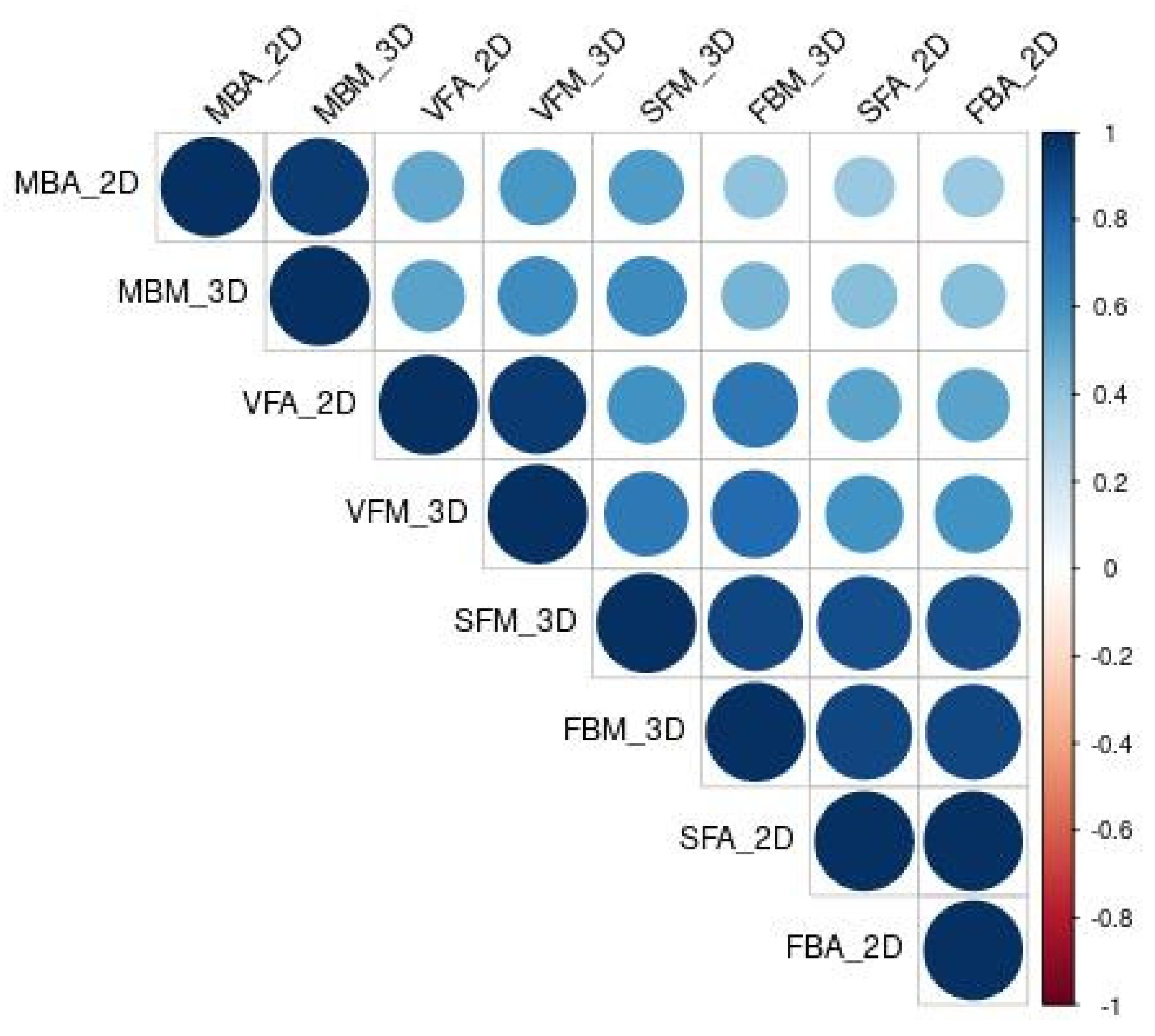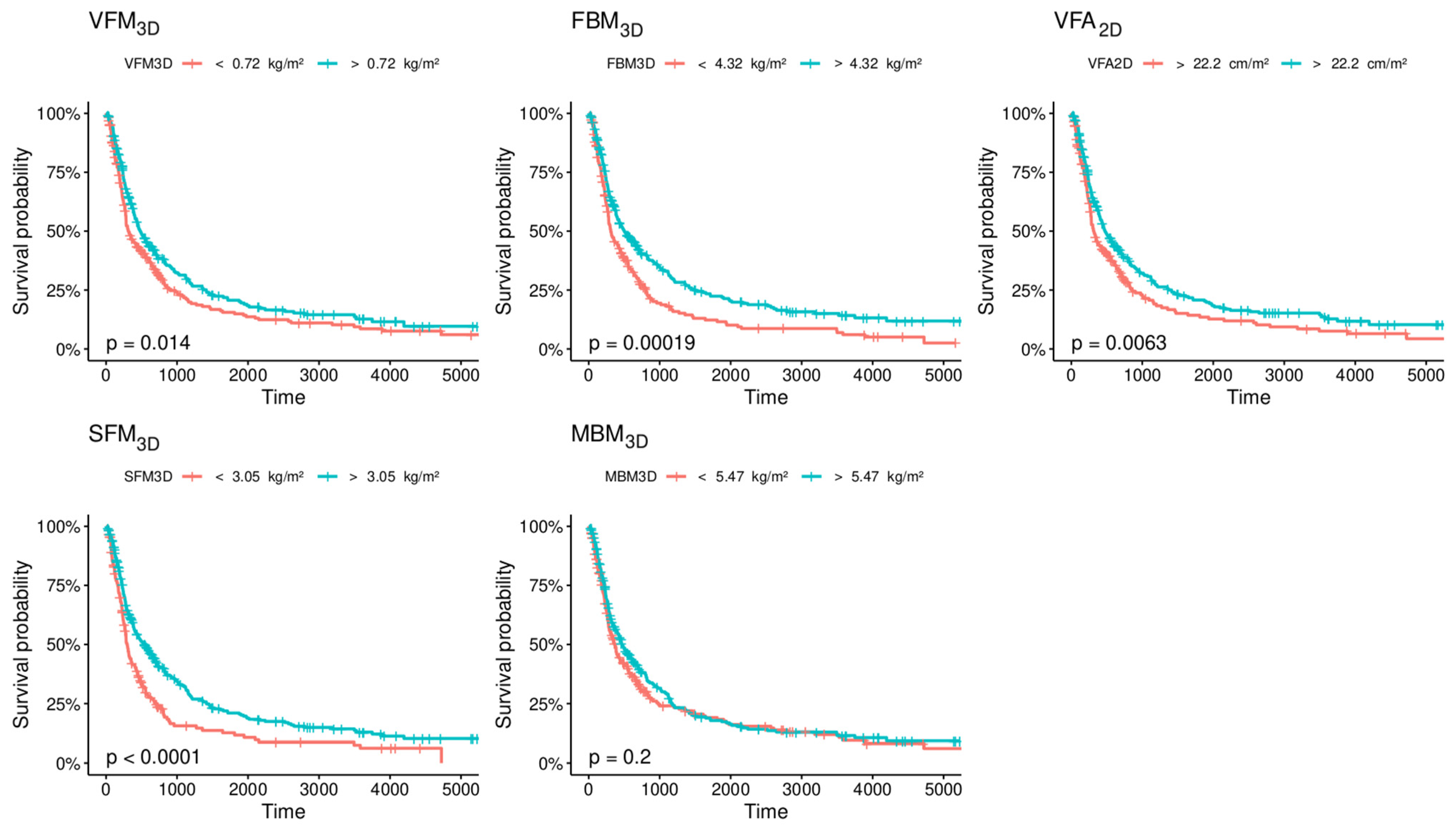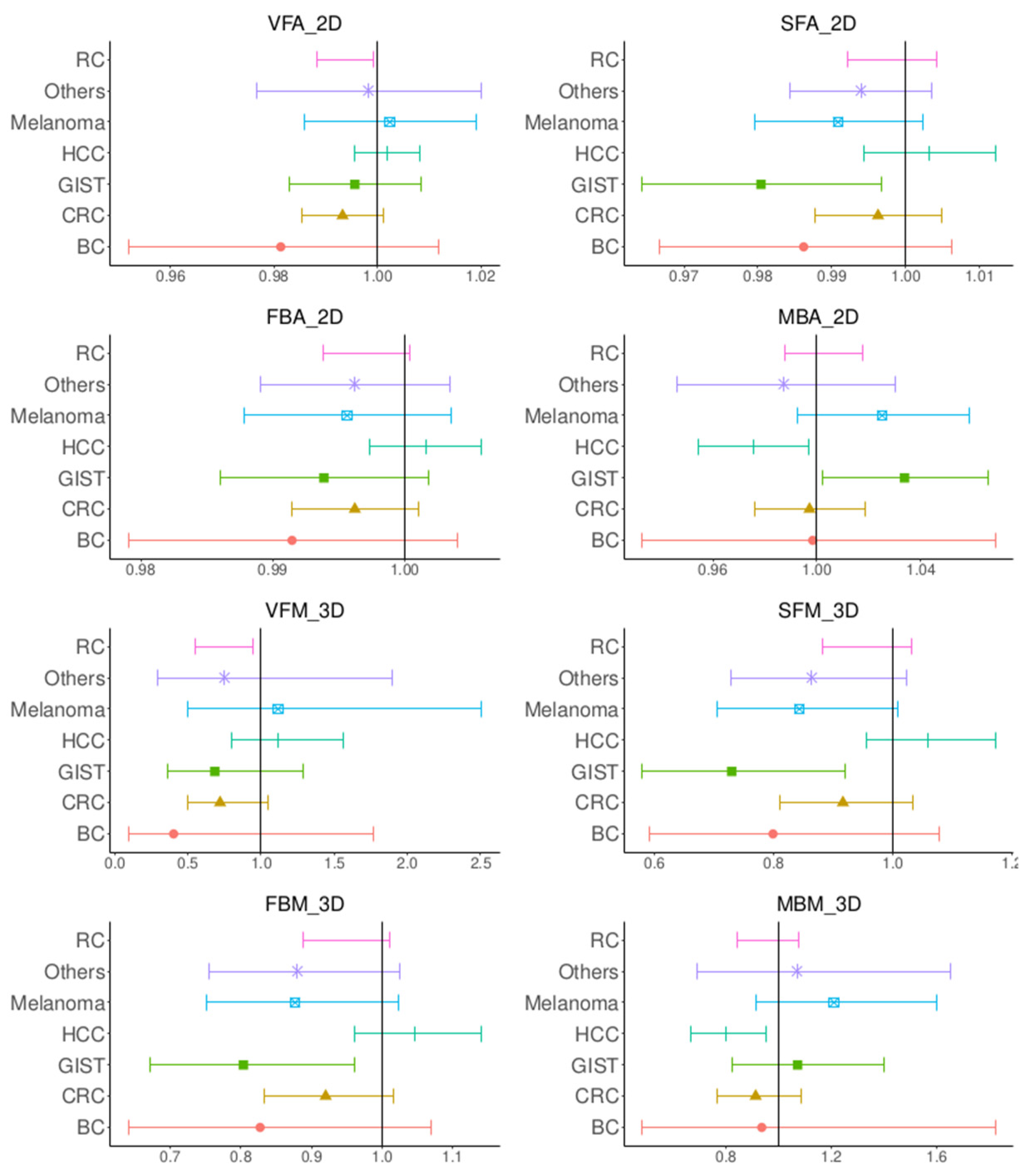Body Composition to Define Prognosis of Cancers Treated by Anti-Angiogenic Drugs
Abstract
1. Introduction
2. Materials and Methods
2.1. Population
2.2. Endpoints and Assessments
2.3. Anthropometric Parameters
2.4. Statistical Analysis
3. Results
3.1. Population
3.2. Survival Analysis
3.3. Sub Analyses
4. Discussion
5. Conclusions
Author Contributions
Funding
Institutional Review Board Statement
Informed Consent Statement
Data Availability Statement
Conflicts of Interest
References
- Escudier, B.; Eisen, T.; Stadler, W.M.; Szczylik, C.; Oudard, S.; Siebels, M.; Negrier, S.; Chevreau, C.; Solska, E.; Desai, A.A.; et al. Sorafenib in Advanced Clear-Cell Renal-Cell Carcinoma. N. Engl. J. Med. 2007, 356, 125–134. [Google Scholar] [CrossRef]
- Demetri, G.D.; Reichardt, P.; Kang, Y.-K.; Blay, J.-Y.; Rutkowski, P.; Gelderblom, H.; Hohenberger, P.; Leahy, M.; von Mehren, M.; Joensuu, H.; et al. Efficacy and Safety of Regorafenib for Advanced Gastrointestinal Stromal Tumours after Failure of Imatinib and Sunitinib (GRID): An International, Multicentre, Randomised, Placebo-Controlled, Phase 3 Trial. Lancet 2013, 381, 295–302. [Google Scholar] [CrossRef] [PubMed]
- Motzer, R.J.; Mazumdar, M.; Bacik, J.; Berg, W.; Amsterdam, A.; Ferrara, J. Survival and Prognostic Stratification of 670 Patients with Advanced Renal Cell Carcinoma. J. Clin. Oncol. 1999, 17, 2530–2540. [Google Scholar] [CrossRef] [PubMed]
- Motzer, R.J.; Bacik, J.; Murphy, B.A.; Russo, P.; Mazumdar, M. Interferon-Alfa as a Comparative Treatment for Clinical Trials of New Therapies against Advanced Renal Cell Carcinoma. J. Clin. Oncol. 2002, 20, 289–296. [Google Scholar] [CrossRef] [PubMed]
- Heng, D.Y.C.; Xie, W.; Regan, M.M.; Warren, M.A.; Golshayan, A.R.; Sahi, C.; Eigl, B.J.; Ruether, J.D.; Cheng, T.; North, S.; et al. Prognostic Factors for Overall Survival in Patients with Metastatic Renal Cell Carcinoma Treated with Vascular Endothelial Growth Factor-Targeted Agents: Results from a Large, Multicenter Study. J. Clin. Oncol. 2009, 27, 5794–5799. [Google Scholar] [CrossRef] [PubMed]
- Patil, S.; Figlin, R.A.; Hutson, T.E.; Michaelson, M.D.; Négrier, S.; Kim, S.T.; Huang, X.; Motzer, R.J. Prognostic Factors for Progression-Free and Overall Survival with Sunitinib Targeted Therapy and with Cytokine as First-Line Therapy in Patients with Metastatic Renal Cell Carcinoma. Ann. Oncol. 2011, 22, 295–300. [Google Scholar] [CrossRef]
- McQuade, J.L.; Daniel, C.R.; Hess, K.R.; Mak, C.; Wang, D.Y.; Rai, R.R.; Park, J.J.; Haydu, L.E.; Spencer, C.; Wongchenko, M.; et al. Association of Body-Mass Index and Outcomes in Patients with Metastatic Melanoma Treated with Targeted Therapy, Immunotherapy, or Chemotherapy: A Retrospective, Multicohort Analysis. Lancet Oncol. 2018, 19, 310–322. [Google Scholar] [CrossRef]
- Renfro, L.A.; Loupakis, F.; Adams, R.A.; Seymour, M.T.; Heinemann, V.; Schmoll, H.-J.; Douillard, J.-Y.; Hurwitz, H.; Fuchs, C.S.; Diaz-Rubio, E.; et al. Body Mass Index Is Prognostic in Metastatic Colorectal Cancer: Pooled Analysis of Patients From First-Line Clinical Trials in the ARCAD Database. J. Clin. Oncol. 2016, 34, 144–150. [Google Scholar] [CrossRef]
- Santoni, M.; Massari, F.; Bracarda, S.; Procopio, G.; Milella, M.; De Giorgi, U.; Basso, U.; Aurilio, G.; Incorvaia, L.; Martignetti, A.; et al. Body Mass Index in Patients Treated with Cabozantinib for Advanced Renal Cell Carcinoma: A New Prognostic Factor? Diagnostics (Basel) 2021, 11, 138. [Google Scholar] [CrossRef]
- Staehler, M.; Stöckle, M.; Christoph, D.C.; Stenzl, A.; Potthoff, K.; Grimm, M.-O.; Klein, D.; Harde, J.; Brüning, F.; Goebell, P.J.; et al. Everolimus after Failure of One Prior VEGF-Targeted Therapy in Metastatic Renal Cell Carcinoma: Final Results of the MARC-2 Trial. Int. J. Cancer 2021, 148, 1685–1694. [Google Scholar] [CrossRef]
- Antoun, S.; Baracos, V.E.; Birdsell, L.; Escudier, B.; Sawyer, M.B. Low Body Mass Index and Sarcopenia Associated with Dose-Limiting Toxicity of Sorafenib in Patients with Renal Cell Carcinoma. Ann. Oncol. 2010, 21, 1594–1598. [Google Scholar] [CrossRef] [PubMed]
- Decazes, P.; Rouquette, A.; Chetrit, A.; Vera, P.; Gardin, I. Automatic Measurement of the Total Visceral Adipose Tissue From Computed Tomography Images by Using a Multi-Atlas Segmentation Method. J. Comput. Assist Tomogr. 2017, 42, 139–165. [Google Scholar] [CrossRef] [PubMed]
- Shen, W.; Chen, J.; Gantz, M.; Velasquez, G.; Punyanitya, M.; Heymsfield, S.B. A Single Mri Slice Does Not Accurately Predict Visceral and Subcutaneous Adipose Tissue Changes During Weight Loss. Obesity 2012, 20, 2458–2463. [Google Scholar] [CrossRef] [PubMed]
- Thomas, E.L.; Bell, J.D. Influence of Undersampling on Magnetic Resonance Imaging Measurements of Intra-Abdominal Adipose Tissue. Int. J. Obes. Relat. Metab. Disord. 2003, 27, 211–218. [Google Scholar] [CrossRef][Green Version]
- Schaudinn, A.; Linder, N.; Garnov, N.; Kerlikowsky, F.; Blüher, M.; Dietrich, A.; Schütz, T.; Karlas, T.; Kahn, T.; Busse, H. Predictive Accuracy of Single- and Multi-Slice MRI for the Estimation of Total Visceral Adipose Tissue in Overweight to Severely Obese Patients. NMR Biomed. 2015, 28, 583–590. [Google Scholar] [CrossRef]
- Decazes, P.; Tonnelet, D.; Vera, P.; Gardin, I. Anthropometer3D: Automatic Multi-Slice Segmentation Software for the Measurement of Anthropometric Parameters from CT of PET/CT. J. Digit Imaging 2019, 32, 241–250. [Google Scholar] [CrossRef]
- Lassau, N.; Chapotot, L.; Benatsou, B.; Vilgrain, V.; Kind, M.; Lacroix, J.; Cuinet, M.; Taieb, S.; Aziza, R.; Sarran, A.; et al. Standardization of Dynamic Contrast-Enhanced Ultrasound for the Evaluation of Antiangiogenic Therapies: The French Multicenter Support for Innovative and Expensive Techniques Study. Invest. Radiol. 2012, 47, 711–716. [Google Scholar] [CrossRef]
- Popinat, G.; Cousse, S.; Goldfarb, L.; Becker, S.; Gardin, I.; Salaün, M.; Thureau, S.; Vera, P.; Guisier, F.; Decazes, P. Sub-Cutaneous Fat Mass Measured on Multislice Computed Tomography of Pretreatment PET/CT Is a Prognostic Factor of Stage IV Non-Small Cell Lung Cancer Treated by Nivolumab. OncoImmunology 2019, 8, e1580128. [Google Scholar] [CrossRef]
- Mallet, R.; Decazes, P.; Modzelewski, R.; Lequesne, J.; Vera, P.; Dubray, B.; Thureau, S. Prognostic Value of Low Skeletal Muscle Mass in Patient Treated by Exclusive Curative Radiochemotherapy for a NSCLC. Sci. Rep. 2021, 11, 10628. [Google Scholar] [CrossRef]
- Ronneberger, O.; Fischer, P.; Brox, T. U-Net: Convolutional Networks for Biomedical Image Segmentation. arXiv 2015, arXiv:1505.04597 [cs]. [Google Scholar]
- Li, Z.; Liu, F.; Yang, W.; Peng, S.; Zhou, J. A Survey of Convolutional Neural Networks: Analysis, Applications, and Prospects. IEEE Transactions on Neural Networks and Learning Systems 2022, 33, 6999–7019. [Google Scholar] [CrossRef] [PubMed]
- Decazes, P.; Métivier, D.; Rouquette, A.; Talbot, J.-N.; Kerrou, K. A Method to Improve the Semiquantification of 18F-FDG Uptake: Reliability of the Estimated Lean Body Mass Using the Conventional, Low-Dose CT from PET/CT. J. Nucl. Med. 2016, 57, 753–758. [Google Scholar] [CrossRef] [PubMed]
- Mendez, J.; Keys, A. Density and Composition of Mammalian Muscle. Metabolism 1960, 9, 184–188. [Google Scholar]
- Chowdhury, B.; Sjöström, L.; Alpsten, M.; Kostanty, J.; Kvist, H.; Löfgren, R. A Multicompartment Body Composition Technique Based on Computerized Tomography. Int. J. Obes. Relat. Metab. Disord. 1994, 18, 219–234. [Google Scholar] [PubMed]
- Lee, Y.S.; Hong, N.; Witanto, J.N.; Choi, Y.R.; Park, J.; Decazes, P.; Eude, F.; Kim, C.O.; Chang Kim, H.; Goo, J.M.; et al. Deep Neural Network for Automatic Volumetric Segmentation of Whole-Body CT Images for Body Composition Assessment. Clin. Nutr. 2021, 40, 5038–5046. [Google Scholar] [CrossRef] [PubMed]
- Pu, L.; Ashraf, S.F.; Gezer, N.S.; Ocak, I.; Dresser, D.E.; Leader, J.K.; Dhupar, R. Estimating 3-D Whole-Body Composition from a Chest CT Scan. Med. Phys. 2022. [Google Scholar] [CrossRef] [PubMed]
- Bredella, M.A. Sex Differences in Body Composition. Adv. Exp. Med. Biol. 2017, 1043, 9–27. [Google Scholar] [CrossRef]
- Vrieling, A.; Kampman, E.; Knijnenburg, N.C.; Mulders, P.F.; Sedelaar, J.P.M.; Baracos, V.E.; Kiemeney, L.A. Body Composition in Relation to Clinical Outcomes in Renal Cell Cancer: A Systematic Review and Meta-Analysis. Eur. Urol. Focus 2018, 4, 420–434. [Google Scholar] [CrossRef]
- Antoun, S.; Birdsell, L.; Sawyer, M.B.; Venner, P.; Escudier, B.; Baracos, V.E. Association of Skeletal Muscle Wasting With Treatment With Sorafenib in Patients With Advanced Renal Cell Carcinoma: Results From a Placebo-Controlled Study. Journal of Clinical Oncology 2010, 28, 1054–1060. [Google Scholar] [CrossRef]
- Labeur, T.A.; van Vugt, J.L.A.; Ten Cate, D.W.G.; Takkenberg, R.B.; IJzermans, J.N.M.; Groot Koerkamp, B.; de Man, R.A.; van Delden, O.M.; Eskens, F.A.L.M.; Klümpen, H.-J. Body Composition Is an Independent Predictor of Outcome in Patients with Hepatocellular Carcinoma Treated with Sorafenib. Liver Cancer 2019, 8, 255–270. [Google Scholar] [CrossRef]
- Schutte, K.; Brulport, F.; Harguem-Zayani, S.; Schiratti, J.-B.; Ghermi, R.; Jehanno, P.; Jaeger, A.; Alamri, T.; Naccache, R.; Haddag-Miliani, L.; et al. An Artificial Intelligence Model Predicts the Survival of Solid Tumour Patients from Imaging and Clinical Data. Eur. J. Cancer 2022, 174, 90–98. [Google Scholar] [CrossRef] [PubMed]




| Characteristic | Patients (N = 526) |
|---|---|
| Sex, n (%) | |
| Male | 377 (71.7%) |
| Female | 149 (28.3%) |
| Age * | |
| Median | 58 |
| Range | [19–83] |
| Tumor, n (%) | Tumor, n (%) |
| Renal cell carcinoma | 204 (38.8%) |
| Colorectal carcinoma | 93 (17.7%) |
| Hepatocellular carcinoma | 72 (13.7%) |
| Gastrointestinal stromal tumor | 56 (10.6%) |
| Melanoma | 42 (8.9%) |
| Breast cancer | 27 (5.1%) |
| Others | 32 (6.1%) |
| Antiangiogenic treatment, n (%) | |
| Bevacizumab | 137 |
| Sunitinib | 117 |
| Sorafenib | 107 |
| Axitinib | 34 |
| Imatinib | 32 |
| Other | 101 |
| Mean Median (+/−SD) [Min-Max] | Cut-Off Value | AUC | Sensitivity | Specificity | Accuracy | p-Value | |
|---|---|---|---|---|---|---|---|
| Line of treatment | 2.07 2 (±1.47) [1–10] | 2 | 0.63 | 0.61 | 0.60 | 0.60 | < 0.001 |
| VFM3D | 0.85 kg/m2 0.75 kg/m2 (+/−0.62) [0.04–3.25] | 0.72 | 0.554 | 0.56 | 0.54 | 0.55 | 0.02 |
| SFM3D | 4.18 kg/m2 3.88 kg/m2 (+/−2.27) [0.13–13.87] | 3.05 | 0.544 | 0.73 | 0.41 | 0.57 | 0.047 |
| FBM3D | 5.03 kg/m2 4.70 kg/m2 (+/−2.70) [0.17–16.12] | 4.32 | 0.550 | 0.63 | 0.48 | 0.56 | 0.03 |
| MBM3D | 5.74 kg/m2 5.65 kg/m2 (+/−1.35) [2.44–10.83] | 5.47 | 0.565 | 0.60 | 0.49 | 0.58 | 0.007 |
| VFA2D | 36.85 cm2/m2 30.01 cm2/m2 (+/−30.86) [0.01–161.91] | 22.20 | 0.548 | 0.64 | 0.46 | 0.55 | 0.034 |
| SFA2D | 53.14 cm2/m2 47.16 cm2/m2 (+/−30.86) [0.77–184.63] | NA | 0.533 | NA | NA | NA | 0.10 |
| FBA2D | 89.99 cm2/m2 86.07 cm2/m2 (+/−53.17) [2.52–243.48] | NA | 0.543 | NA | NA | NA | 0.052 |
| Whole Population (Men and Women) | Men | Women | ||||
|---|---|---|---|---|---|---|
| HR | p-Value | HR | p-Value | HR | p-Value | |
| Sex | 0.96 | 0.70 | ||||
| Age | 1.00 | 0.395 | 1.00 | 0.97 | 1.00 | 0.58 |
| Line of treatment | 0.88 | < 0.0001 | 1.28 | < 0.0001 | 1.14 | 0.0067 |
| VFM3D | 0.55 | 0.12 | 0.73 | 0.0026 | 0.87 | 0.52 |
| SFM3D | 0.98 | 0.46 | 0.93 | 0.036 | 0.94 | 0.11 |
| FBM3D | 0.99 | 0.31 | 0.93 | 0.014 | 0.95 | 0.14 |
| MBM3D | 0.93 | 0.05 | 0.89 | 0.024 | 0.85 | 0.14 |
| VFA2D | 1.00 | 0.33 | 0.99 | 0.015 | 1.00 | 0.48 |
| SFA2D | 1.00 | 0.47 | 0.99 | 0.027 | 1.00 | 0.47 |
| FBA2D | 1.00 | 0.33 | 0.997 | 0.009 | 1.00 | 0.44 |
Disclaimer/Publisher’s Note: The statements, opinions and data contained in all publications are solely those of the individual author(s) and contributor(s) and not of MDPI and/or the editor(s). MDPI and/or the editor(s) disclaim responsibility for any injury to people or property resulting from any ideas, methods, instructions or products referred to in the content. |
© 2023 by the authors. Licensee MDPI, Basel, Switzerland. This article is an open access article distributed under the terms and conditions of the Creative Commons Attribution (CC BY) license (https://creativecommons.org/licenses/by/4.0/).
Share and Cite
Decazes, P.; Ammari, S.; De Prévia, A.; Mottay, L.; Lawrance, L.; Belkouchi, Y.; Benatsou, B.; Albiges, L.; Balleyguier, C.; Vera, P.; et al. Body Composition to Define Prognosis of Cancers Treated by Anti-Angiogenic Drugs. Diagnostics 2023, 13, 205. https://doi.org/10.3390/diagnostics13020205
Decazes P, Ammari S, De Prévia A, Mottay L, Lawrance L, Belkouchi Y, Benatsou B, Albiges L, Balleyguier C, Vera P, et al. Body Composition to Define Prognosis of Cancers Treated by Anti-Angiogenic Drugs. Diagnostics. 2023; 13(2):205. https://doi.org/10.3390/diagnostics13020205
Chicago/Turabian StyleDecazes, Pierre, Samy Ammari, Antoine De Prévia, Léo Mottay, Littisha Lawrance, Younes Belkouchi, Baya Benatsou, Laurence Albiges, Corinne Balleyguier, Pierre Vera, and et al. 2023. "Body Composition to Define Prognosis of Cancers Treated by Anti-Angiogenic Drugs" Diagnostics 13, no. 2: 205. https://doi.org/10.3390/diagnostics13020205
APA StyleDecazes, P., Ammari, S., De Prévia, A., Mottay, L., Lawrance, L., Belkouchi, Y., Benatsou, B., Albiges, L., Balleyguier, C., Vera, P., & Lassau, N. (2023). Body Composition to Define Prognosis of Cancers Treated by Anti-Angiogenic Drugs. Diagnostics, 13(2), 205. https://doi.org/10.3390/diagnostics13020205






